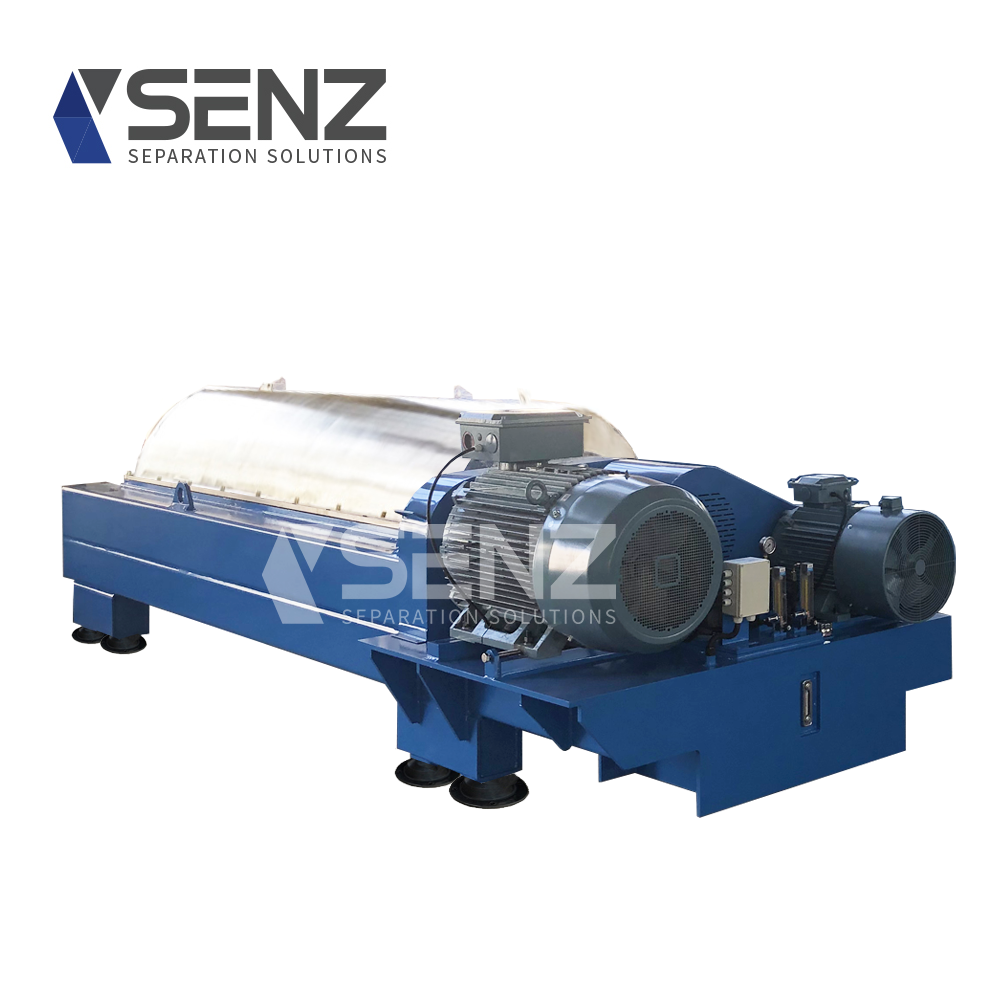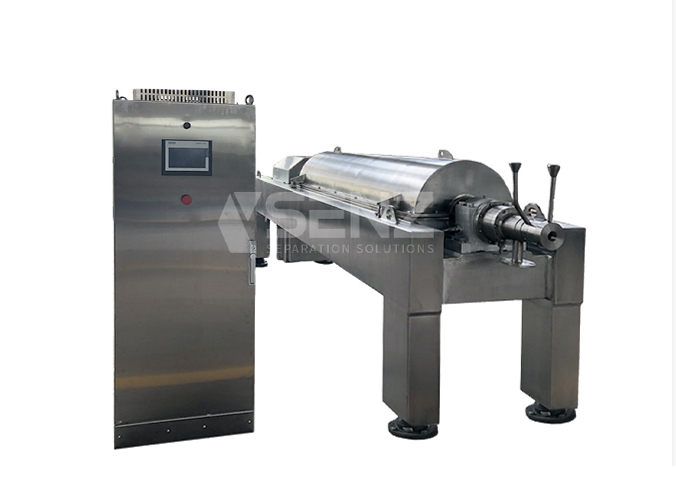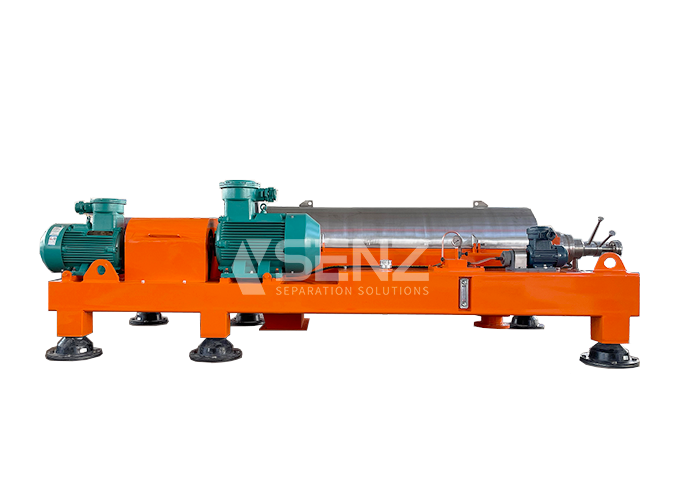Product Introduction
LW760 horizontal spiral sedimentation centrifuge: This equipment is a LW series product, commonly used for dehydration and concentration. Widely used for maximum dewatering requirements of municipal and industrial wastewater sludge. It is characterized by small size, high rotational speed, and small processing capacity, and is used in situations where large separation factors and small processing capacity are required. According to practical use, it can be divided into: clarification type, dehydration type, concentration type, separation type, classification type, extraction type; Users can choose by themselves. Dehydration horizontal spiral centrifuge is suitable for easily separated materials with large particle size, large solid-liquid density difference, low viscosity, high concentration, strong processing capacity, and higher dryness than clarity. Materials such as sludge or wastewater containing fine particles usually require the addition of flocculants to condense the fine particles into large particles, which are then dewatered using a sedimentation centrifuge.
Working principle
The horizontal screw centrifuge relies on the density difference between the solid and liquid phases to accelerate the sedimentation rate of solid particles under the action of centrifugal force to achieve solid liquid separation. The centrifuge consists of two rotors, one called a drum, and the other rotor is a screw discharger (referred to as a screw). When the drum rotates at a high speed, the slurry inside the drum rotates with the drum and is subjected to a centrifugal force that is many times greater than gravity. In this way, solid particles will be separated from the liquid and settle onto the inner wall of the drum from the centrifuge drum shaft. The screw discharger located inside the drum rotates at a speed lower than the drum and pushes the deposited solid particles to the slag outlet, The differential rotational speed between the outer drum and the screw discharger depends on the transmission ratio of the differential and its rotational speed.
Product Features
- The liquid clarification device adopts a horizontal design, balancing the layout of the motor and bowl. Therefore, excellent operational stability minimizes vibration.
- Dual motor control allows stepless speed regulation of bowl and screw components.
- The screw conveyor blades in the continuous centrifuge are made of wear-resistant alloy spraying or cemented carbide welding. In addition, the main components of our horizontal horizontal spiral centrifuge, such as the rotating bowl and screw components, are made of corrosion resistant stainless steel or duplex steel, providing special speed limits and separation ratios.
- There are three options for mud dewatering equipment, including cycloidal gears, planetary gears, and hydraulic differentials, to achieve wide range differential adjustment. Therefore, the industrial centrifuge is suitable for various solids.
- Various protections to ensure safe operation, including over vibration protection, bearing temperature detection, screw conveyor torque protection, rotation and differential speed detection, as well as nitrogen filled explosion-proof protection, motr overload and overheating protection.
- JG type rubber shock absorbers do not require anchor bolts.

Product name: LW760 horizontal spiral sedimentation centrifuge
Product Usage: Petroleum, Chemical, Light Industry, Pharmaceutical, Food, Environmental Protection, Urban/Industrial Wastewater, etc
Product Material: Product contacts can be made of austenitic stainless steel (321, 316L...), Haynes alloy, titanium alloy, or other anti-corrosion materials.
Applications: General
Materials: The contact parts can be made of austenitic stainless steel (304, 316, 321L...) 2205, 2304, 2507, Hastelloy, titanium alloy, or other anti-corrosion materials.
Standard configuration: ordinary motor, standard control cabinet
Color: customizable
Optional configuration: explosion-proof motor, power supply voltage, frequency converter ABB/Siemens
Scope of application
The equipment has the characteristics of continuous feeding and discharging. The chemical separation equipment has been applied to two-phase (solid liquid) and three-phase (solid liquid liquid) slurry separation in chemical, pharmaceutical, environmental protection, mining, food and other industries. The various materials listed below are only partially used, and various new uses are increasing. For specific materials, it is necessary to pass tests or analogies to determine the type and technical parameters of the corresponding centrifuge. Chemical, petroleum, food, pharmaceutical, kitchen oil and water residue, magnetic particle treatment, sewage treatment plants, pharmaceutical plants, food plants, laboratories, petroleum industry, new energy industry, biotechnology, chemical fiber, polymeric materials, leather manufacturing, cosmetics, printing and dyeing plants, knitting plants, environmental protection technology, and so on.
Chemical industry: polyethylene, polystyrene, fumaric acid, urea, ammonium sulfate, potassium nitrate, polyamide, caprolactam, sodium carbonate, compound fertilizers, sodium chloride, traditional Chinese medicine, sodium sulfite, bile alum, PVC, ferrite, polypropylene glycol, activated carbon, various resins, etc.
Food: Citric acid, tartaric acid, sodium glutamate, amino acids, salt, granulated sugar, xylitol, corn fiber, saccharin, flax, coffee, etc.
Mining industry: iron sulfate, copper sulfate, nickel sulfate, amine thiocyanate, etc.
Industrial and municipal wastewater treatment
Oil and gas drilling mud/drilling fluid control
Washing, Separation, and Dehydration of Starch
Isolation of Antibiotics from Mycelia and Fermentation Broth
Dehydration of Soybean and Wheat Protein
Dehydration of fish meal and meat
Dehydration of distiller's grains.
Clarification and Extraction of Fruit Juice
Isolation and purification of animal and vegetable oils
Production and purification of olive oil, palm oil, and avocado oil
Separation and purification of coal tar
Classification of kaolin and graphite
Grading and dehydration of dyes and pigments
Clean coal foam flotation and slime dewatering
Working principle of mineral classification and dehydration
Characteristics of suspension materials
The larger the solid particles in the material, the easier it is to separate. The size of the solid particles varies, and the final separation effect is determined by the small particle solid phase. This machine can generally remove solid particles above 5 um. When the solid particles are especially small, they will not settle and separate out, but will be discharged together with the clarified liquid; The final separation effect depends on the distribution of solid particles in the material. The more particles above 5 um, the better the separation effect; On the contrary, the separation effect is worse.
Generally, crystalline solids and fibrous solids are easier to separate, while flocs and paste solids are more difficult to separate. Due to the large maximum water solubility of flocs and paste solids, when spirally pushing sediment, it is easy to slip and affect the separation effect, so the flow rate should not be too large when separating flocs and paste solids.
The greater the weight difference between the solid phase and the liquid phase, the better the separation, and vice versa, the worse the separation effect
The lower the liquid viscosity, the easier it is to separate. When the liquid viscosity is higher, the solids entrained in the clarified liquid increase, and the separation effect becomes worse. At this time, the material temperature can be increased and the viscosity can be reduced to improve the separation effect (the maximum feed temperature is not greater than 95 ℃).
Selection of feed flow (i.e., processing capacity)
From a separation perspective, the smaller the feed flow rate, the smaller the axial flow rate of the material in the drum, the longer the residence time of the material in the drum, and the better the separation effect. As the feed volume increases, the axial flow rate increases, and the retention time of the material in the drum decreases. The separation effect becomes worse. The feed volume of the centrifuge is also limited by the maximum slag removal capacity of the spiral. If the feed volume is too large, the separated sediment will not be discharged in a timely manner, resulting in blockage of the drum. Therefore, when using the centrifuge, the appropriate feed flow rate should be selected based on the material characteristics, separation requirements, and the solid content of the material, Generally, when the solid content is large, the feed rate should not be too large. The appropriate feed rate can be determined after comparing the separation effects of various flows. Generally, it is recommended that the flow rate should not be too large for materials that are difficult to separate, and the flow rate for materials that are easy to separate can be larger. However, attention should be paid to the maximum slag discharge amount of the spiral, otherwise it will cause material blockage.






